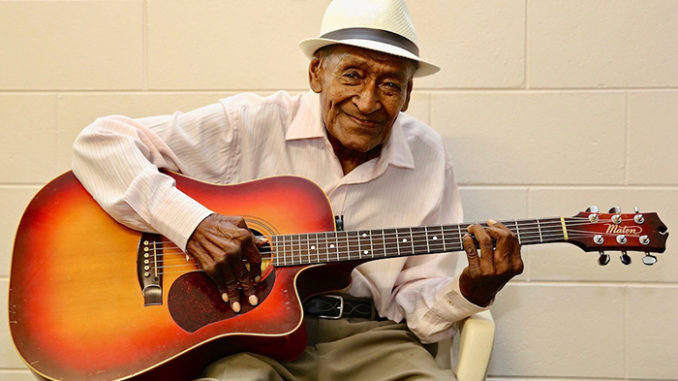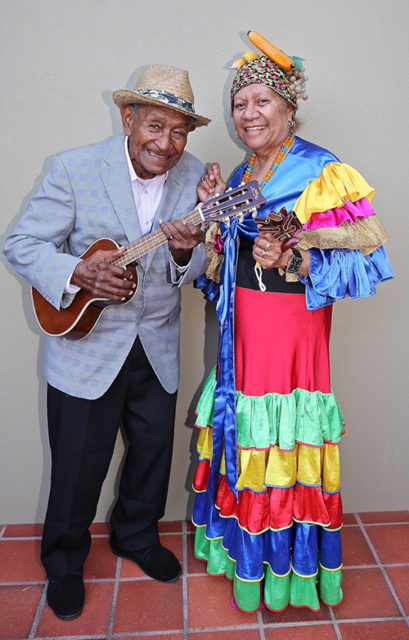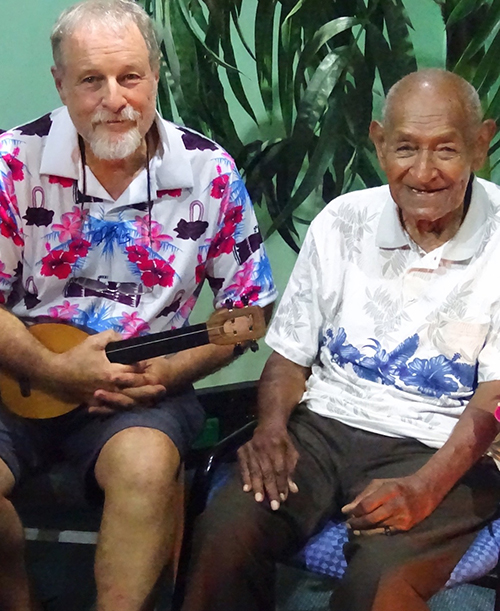
TONY HILLIER, who has chronicled Seaman Dan’s extraordinary recording career from its inception, recounts one of Australian music’s most heart-warming success stories.
For two thirds of his working life, Henry Gibson Dan plied his trade in the seas of tropical north Australia as a deep-water pearl shell diver and boat skipper. In the final 20 of his 91 years, the man who became known far and wide as Seaman Dan planted the Torres Strait flag firmly on the national and international maps with his mellifluous singing, catchy songs and storytelling skill.
An unexpected proposition from a visitor to the Torres Strait in the last year of the 20th century — coincidentally on the same day in 2021, January 15th, in which he was buried in the place of his birth, tiny Thursday Island — paved the way for Uncle Seaman’s surprise rise to the upper echelon of Australia’s roots music ranks.
Dr Karl Neuenfeldt, a Bundaberg-based academic and musicologist, was interviewing local indigenous artists on T.I. as part of a research project. A successful singer-songwriter in his younger days in Canada, Neuenfeldt recognised Seaman’s talent after hearing him sing a couple of songs and suggested he might like to make a recording, an offer that the Islander quickly accepted. Neuenfeldt approached music producer and former Steeleye Span drummer Nigel Pegrum, whose Cairns studio has been home for all of Seaman’s recordings.
Between them they masterminded a career that concluded when Seaman passed away peacefully in his sleep at a nursing home outside of Cairns five days after Christmas.
Neuenfeldt and Pegrum became trusty mentors, guiding Seaman’s recordings and gigs with the wisdom and consideration that his age required and the quality of his singing demanded. As the latter waxes: “Seaman Dan’s voice had a beautiful velvety, rich depth. The way he phrased was different from contemporary singers … it came from a bygone era. He was a totally natural musician. With unerring accuracy of pitch and consummate phrasing, he turned everything he sang into his own personal rendition.”
Neuenfeldt concurs: “From a producer’s point of view, an aged voice just has a quality that a 20-year-old can’t have and it’s not just the actual quality of voice; it’s the maturity in the delivery of the song. Musically, Seaman was blessed with a fine natural singing voice and he wrote and sang songs about real life adventures and memories. ”
With inspired guidance, this gentle and unassuming Old Man of the Sea sailed on to the country’s airwaves and into national awareness, his songs featuring in soapies and surf movies and his story on to ABC and SBS television and radio documentaries. Seaman Dan’s belated recording career snared a swag of Australian music industry awards. As a 75-year-old in 2004, he became the country’s oldest ARIA award-winning recipient for his album Perfect Pearl. So excited was he to be at the presentation ceremony overlooking Sydney Harbour that he nearly didn’t hear then NSW Premier Bob Carr hailing him the winner.
Pegrum recalls: “We were standing in the corner of the venue feeling a bit ‘why are we here’. When the moment of the announcement came for the World Music award all heads swivelled to the back of the throng where we were standing. Uncle proudly walked onto the small stage. He accepted the award most gracefully and in his short speech thanked all the people of the Torres Strait for their lifelong support.”

In the same year as his first ARIA award, Seaman Dan represented Australia at the World Expo in Japan on his maiden voyage overseas. Five years later he picked up another gong for best World Music album with Sailing Home, released just four months shy of his 80th birthday. Seaman was already a septuagenarian when he recorded his 2000 debut Follow The Sun, an album financed by Neuenfeldt.
With characteristic modesty, the diminutive singer always attributed his success to his manager “Doctor Karl” and his sound engineer and co-producer Nigel Pegrum. “It was a challenge for me,” he once revealed in an interview with your correspondent, adding: “They coached me how to perform in the studio.” But Seaman rose magnificently to the challenge of performing in an unfamiliar environment. “He adjusted to the precision needed for studio singing very quickly,” relates Neuenfeldt. “He never pretended to understand the technology, but he understood very well his role in the recording process,” Pegrum adds.
The subject matter of Seaman’s music led the production team that included a veritable ‘A’ team of local backing musicians — Will Kepa, Kirk Steel, Steve Gilbert, Tommy See Poy, Wayne McIntosh, Giles Smith and Andree Baudet — among them to many musically interesting places and genres. The singer’s songs, brilliantly arranged by the crew, were filtered through his multicultural heritage, work in the maritime industry, his love of family and friends, and life in Torres Strait, Broome and Darwin. As Seaman always asserted: “The Torres Strait is a true multicultural society”. His own pedigree contained African-American, Melanesian, Polynesian and Caribbean ancestry, while his music trawled through a corresponding reservoir of blues, jazz, reggae and hula styles with Melanesian and Polynesian inflection.
On Seaman Dan’s albums, boating and pearling songs sat side-by-side with traditional Islander tunes. He absorbed myriad influences to evolve his own distinctive style, which he referred to as ‘Island Blues’. “Thanks to the pearling industry, I heard songs from all over the world,” he told me in one interview. “Growing up, you’d listen to elderly people as they sang and add bits and pieces to your own songs.”
A passion for music developed when young Henry was eight, after he relocated to Coen on the Cape York Peninsula just before World War II. “My Mum had one of those wind-up gramophones and we had a lot of records by Tex Morton, Wilf Carter and Jimmy Rogers,” he revealed in another interview. Rogers was Master Gibson’s favourite. “I used to sing ‘Hillbilly Blues’,” he recalled with a chuckle.
While based in Coen, he was introduced to the thought of being able to play and sing by Val McGuiness, who went on to be a significant musician in Darwin. Seaman’s ‘education’ was advanced further in the war years during sorties to Cairns, where he heard American servicemen playing at local parties. “They used to sing jazz and blues, and so I learnt lots of different chords,” he told me. His first song, ‘Little Pony’ (featured on Follow The Sun) was penned as a 14-year-old while working as a jackaroo on Cape York.

After sailing to Darwin in 1952, Seaman Dan’s musical career ascended to another level. It was in the N.T. capital that he first performed professionally in hotels, clubs, community dances and social functions. A saxophonist mate who played in a quartet at the Hotel Darwin invited him to guest during the band’s 15 minutes break. Back then he crooned standards such as ‘Embraceable You’ and ‘Making Whoopee’ (which decades later he covered on the 2012 album Sunnyside). When the audience realised he was from the Torres Strait, they’d always request ‘Old T.I.’. But every time he performed the song he’d get homesick, so he returned to Thursday Island and diving.
A case of the dreaded bends suffered while attempting to take a short cut at the infamous Darnley Deep forced Seaman Dan to give away the diving industry for good. But, despite having more time on terra firma his musical career throughout the 1970s and 1980s was fractured at best. In 1983 he was invited to entertain the tourists at the Torres Hotel — gratis mind you. “I once got a 40 cents tip; the next week I got shouted a can of XXXX,” he recalled, adding: “I thought, gee whiz this is good.”
In later days, Seaman Dan serenaded punters regularly at the Gateway Resort and Wongai Hotel on Horn Island, where his house was situated, and actually got paid for the gigs! There were only about 450 people on Horn Island, but his gigs attracted a quarter of them. During the tourist season at weekends he used to meet the boats at T.I. across the water and perform at the Torres Hotel — that’s when he wasn’t touring the mainland or performing at some of Australia’s biggest festivals.

Seaman Dan, an affable man who charmed everyone he met, used to delight in recalling the meeting with Karl Neuenfeldt that set up his brilliant recording career. “I sang five songs for him at the radio studio on T.I. and we repaired to the Grand Hotel for some lunch. I was eating away and Karl said, ‘you know Seaman you have a nice voice — would you like to make a CD. I put my knife and fork down. I said ‘I beg your pardon’. He repeated what he had said before, and I thought to myself this is the opportunity I’ve been waiting for for a long, long time. I grabbed it with both hands, and I said ‘yes please’. We’ve never looked back.”
Seaman was spot on with that assertion. Apart from the aforementioned ARIA awards, he scooped a Screen Sound National Folk Recording Award (2001), a Red Ochre Award (2005), the Jimmy Little Lifetime Achievement Award (2009), the National Indigenous Hall of Fame Award (2013) and the Grant McLennan Lifetime Achievement Award at the Queensland Music Awards (2019). In 2020, his final year, Seaman Dan was appointed a Member of the Order of Australia for his services to the arts for “significant service to the music community and to the indigenous community”.
In his younger days, Seaman Dan drew inspiration from legends like Nat King Cole, Frank Sinatra, Dean Martin and Bing Crosby. Young Torres Strait Islanders and Indigenous kids on the mainland now look up to Uncle Seaman. That may well be the greatest legacy of this lovable man.
It was a love of entertaining and informing — not money — that motivated Seaman Dan. He was always extremely generous with his time, whether he was visiting schools and encouraging children to sing and play music, or talking to festivalgoers or people at conferences. He was always willing to share his beloved Torres Strait culture and to promote music in general. By utilising the local languages of the Strait in his songs, this proud Islander put a very special part of Australia in the spotlight.
Karl Neuenfeldt marvelled at Seaman’s politeness and how he was so glad, and honoured, to tell tales about sharks, cyclones and shipwrecks … especially to kids with their wide eyes and credulity. “Over 22 years of friendship, I learnt a lot from him, not just about music and singing but also life.
“A favourite saying of his was ‘steady, steady” — a term about sailing a pearling lugger steadily when the divers were down below gathering pearl shells hoping against hope to also find a rare pearl. From that analogy, I learned to try to focus more on the moment and not get lost in the clutter and chaos of day-to-day dreams and dilemmas. Just as the way he sang, he also took things slowly and for him that worked fine. I will miss him as a friend who was willing to trust Nigel Pegrum and I to guide him and the musicians and singers to help polish his already unique music.
“Seaman was a gentle man, appreciative to all who worked with him. He was certainly ‘old school’ — how could he not be at his age — but so ‘old school’ he was ‘new school’, too. When I asked him once how it felt to get recognition so late in life, he replied ‘My hat still fits’. And that sums up his pride in having accomplished making some great music and telling some great stories yet also keeping it in perspective. So goodbye old friend and in Torres Strait language, yawo/farewell … you have sailed home for the final time.”
Vale Uncle Seaman … you’ll be greatly missed.
Seaman Dan’s eight albums (and two compilations) are available through Planet/MGM. Karl Neuenfeldt’s book, Steady, Steady: The Life and Music of Seaman Dan through Aboriginal Studies Press.

